Heavy Gear (2nd Ed.) by Poison Mushroom
The Not-Inner Sphere, and the Not-Clans
Original SA post Heavy Gear, Second Edition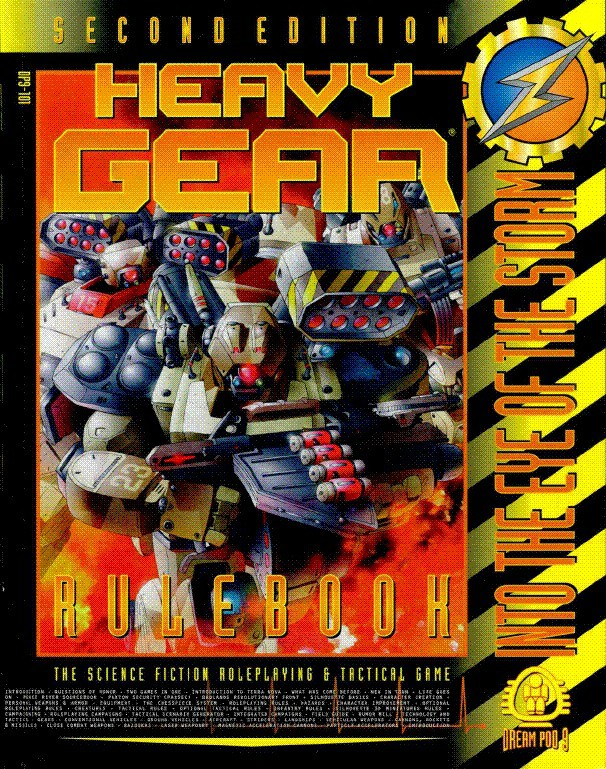
 Look at that awesome mecha art! ...oh, no. Oh, no no no. I remember CthulhuTech. I remember Mekton. It's a trap! This game is going to use fancy cover art to lure me into a false sense of security before it rapes me with terrible mechanics and actual rape, isn't it?!
Look at that awesome mecha art! ...oh, no. Oh, no no no. I remember CthulhuTech. I remember Mekton. It's a trap! This game is going to use fancy cover art to lure me into a false sense of security before it rapes me with terrible mechanics and actual rape, isn't it?!
Well, no, actually. See, the Silhouette system is some unholy amalgam of roleplaying game, and wargame. It means that the RPG rules are a little sketchy at time, but that because grognards.txt would explode if the math was off, the mechanics are actually fairly solid. But I'm getting ahead of myself.
Heavy Gear Second Edition, Part 1: The Not-Inner Sphere, and the Not-Clans
The first few pages of the book present themselves as a briefing document for an Earth soldier. But, after a couple of space and land maps, this gets dropped completely, in favor of a more standard info-dump. Ignoring the pretentious bits, it's actually really damn simple.
In sufficiently-high-number AD, Earth began colonization efforts of several planets, including the focus of most of the Heavy Gear stuff, Terra Nova. They pour shitloads of money into the colonies, believing it will be a long-term investment. But, as time goes on, they begin to realize just how expensive this whole thing has been and worry that they won't be paid back, instead demanding independence. So, with an astounding lack of appreciation for irony, the Earth governments cut their losses, leaving the colonies to figure out their own shit.
Four hundred years, someone on Earth gets the bright idea to head on out into space again to see about those four hundred years of back taxes that are owed, and the colonies tell them to get bent. With bullets. In the time that Earth was gone, Terra Nova developed two very convenient, if somewhat implausible governments, one on the northern hemisphere, and one on the south, with a band of inhospitable desert in the middle. The two sides team up to kick Earth's ass, then go right back to fighting with each other and themselves in ways that make a campaign setting conductive to wargaming.
TL;DR Earth made some colonies, left them to their own shit, then came back and expected to get paid. The colonies are fighting amongst themselves, on a planet that is quite literally split right down the middle.
Despite this retardedly simple set-up, there is apparently an extensive metaplot. Wikipedia claims that there have been several million words written for the campaign setting. I blame the video games and TV show. (Did I mention there were video games and a TV show?) But none of that's why you're here. You're here to make your stompy death machiens shoot other stompy death machines!
Unfortunately, this is not

There's a bunch of different planets that the core book doesn't really mention (so they can sell you splatbooks, of course.) They're pretty simple, of course, but there's one for just about every kind of stupid stereotype you can think of.
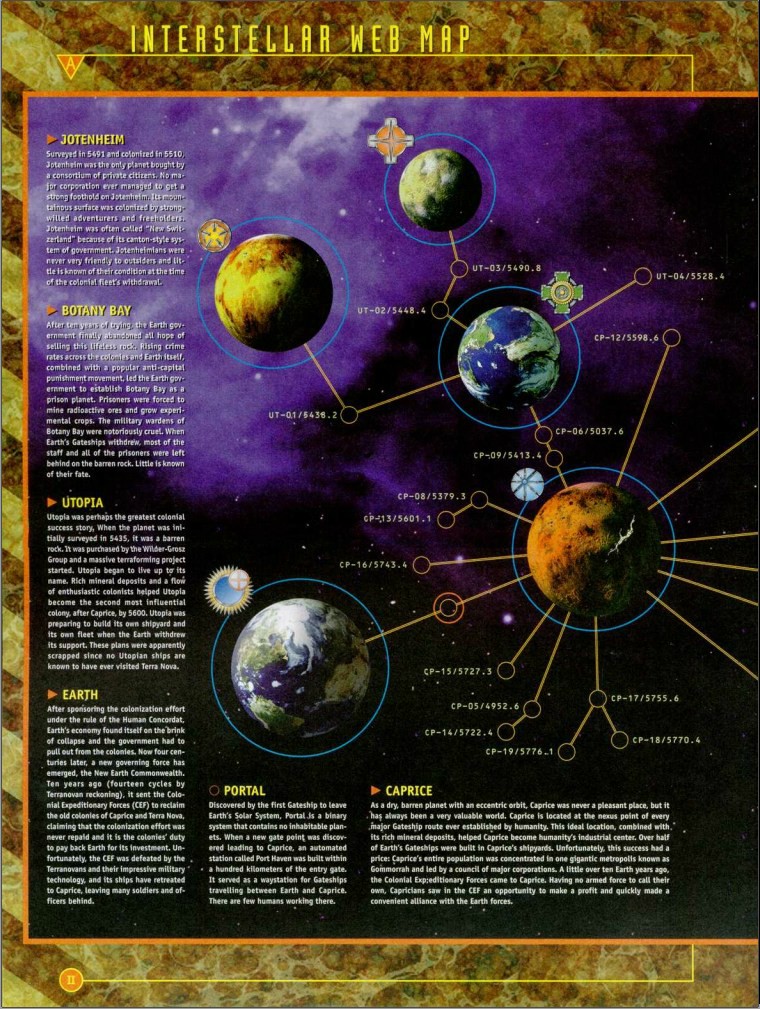
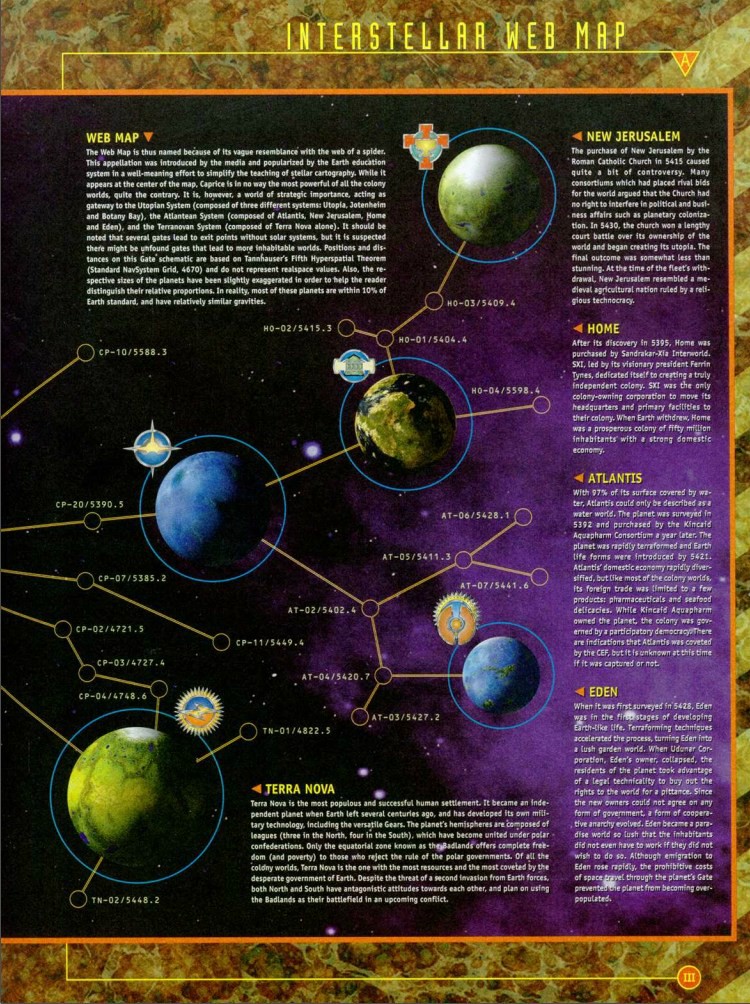
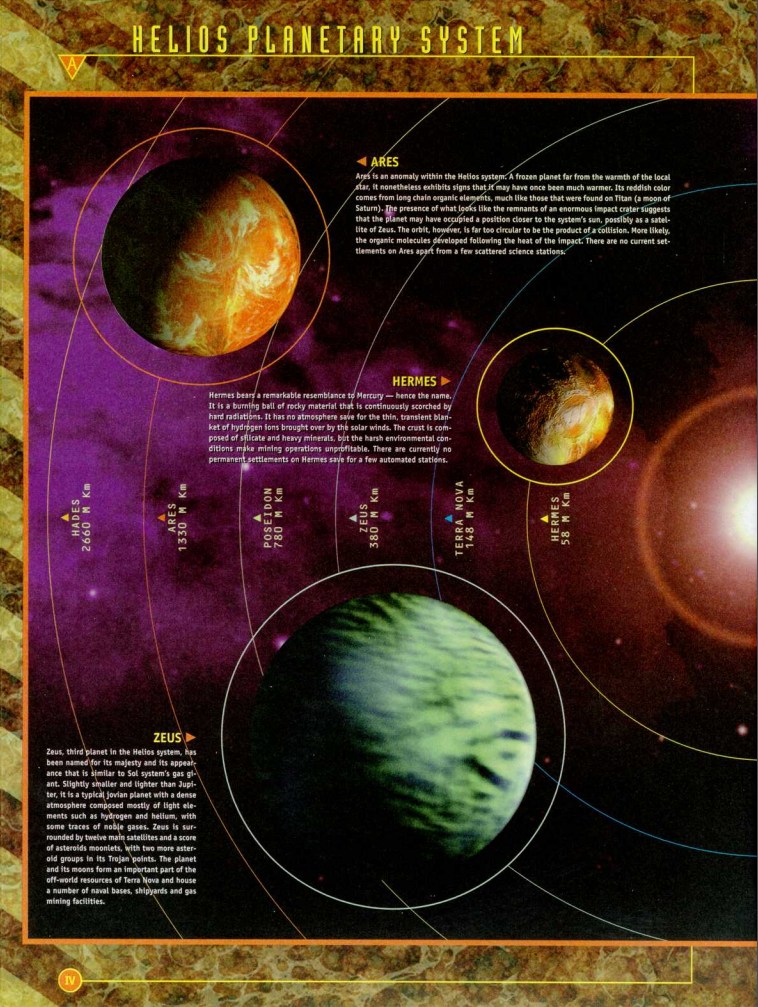

For example, there's Jotenheim , which is the Switzerland/Canada planet, Eden , the Hippie planet, New Jerusalem , the
 planet,
Home
, the LF planet, and
Botany Bay
, the planet that was so goddamn hardcore, Earth eventually just gave up on colonizing it and started dumping prisoners there.
planet,
Home
, the LF planet, and
Botany Bay
, the planet that was so goddamn hardcore, Earth eventually just gave up on colonizing it and started dumping prisoners there.
 Thrilling stuff, that. Also, apparently, Terra Nova years are like 40% shorter than Earth years, but everyone still treats ages the same.
Thrilling stuff, that. Also, apparently, Terra Nova years are like 40% shorter than Earth years, but everyone still treats ages the same.

I could go into more detail about the fluff, but honestly...
 .
.
Coming Up: Bell curves!
How I Learned To Stop Worrying And Love The Bell Curve
Original SA post Heavy Gear Second Edition, Part 2 or: How I Learned To Stop Worrying And Love The Bell CurveThis is technically Chapter Four, because the book spends three short chapters on the fluff, but I introduced everything that needs introducing, so we're gonna hop right on ahead.
The chapter begins with a quick introduction of the Silhouette game system, and an explanation that it's adept for wargaming, tabletop roleplaying, or anything in between. Although why you'd buy the Heavy Gear book if you weren't interested in giant robots is beyond me.
Most rolls, in both the wargame, and the roleplaying game, involve rolling a certain number of D6, and comparing them to a target number. Pretty simple. What's different about it, though, is that you don't total all the dice. Instead, you simply pick out the highest one, and, if you get several sizes, add +1 for each after the first. Increasing your skill increases the number of dice you roll, while your attributes give you a small flat modifier, with a range of -3 to +3. If you don't have ranks in a skill, you instead roll two dice, and pick the lowest , which greatly increases your chance to fumble. (I'll get to that in a second.)
What this means is that the game can use relatively static target numbers, and not have to scale things up as you go. An increase from 2d6 to 3d6 increases your average a fair amount, but your maximum really only goes up by 1, and even then, only if you get that 1/128 roll of triple-sixes.

The example picture does a pretty good job of explaining it, too.
A Fumble, which happens when you're required to pick a die that rolled a 1 (either because of an untrained skill, or because of absolutely terrible luck), is a catastrophic failure. The book takes pains to point out that this doesn't have to be the roller's fault. For example, if you're attempting to make a piloting roll to do a 180 o turn at top speed, and you fail, you skid an extra square before you turn (possibly crashing into something). If you fumble , you crash. Maybe there was a slippery patch of ground, or your wheels got caught on some undergrowth, or a sudden change of elevation threw off your balance.
Because the wargaming part needs clearly defined rules, there's a small chart that lists out the exact effects for fumbles in those situations, but the book encourages GMs to be creative with what fumbles do in roleplaying sections.
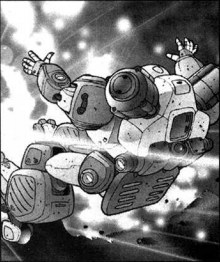
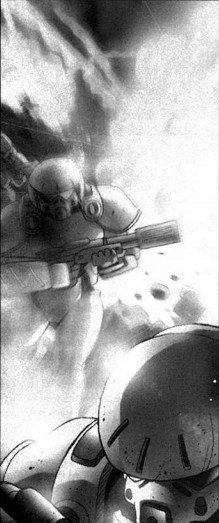
The art in the book itself is still pretty good, and consistent with the style on the cover.
From here, we get to how target numbers and things of that are calculated. The range goes from 1 (spot someone standing on top of a hill waving a flag) to 12 (hear someone breathing fifty yards away). In most cases, as you get above 7, each number becomes increasingly more difficult than the last, so most target numbers are in the range of 4-6. Ties are ambiguous results with no winner (leaning defender-wins, if a draw is infeasible), while anything else gives either Margins of Success, or Margins of Failure.
Really, nothing that you haven't seen before.
There's also a quick section on opposed tests, and an explanation of the different levels of skill (1 die is a hobby, 2 is a job, 3 is a professional, 4 is ridiculous, and 5 is almost inhuman.) Beyond that, is a recommendation that, in the roleplaying game, the GM discourage min-maxing, and that most characters should have a varied range of related skills, rather than just one or two that are as high as possible. It also suggests being a hardass about skill definitions, if players ignore this warning. They want to play someone with a crippling, single-minded obsession, they're going to play someone with a crippling, single-minded obsession. Maybe not the best method, but certainly an interesting one.
Up Next: Character creation!
If you've got a concept you'd like to see, go ahead and throw it out. I'll see what I can do.
I'm a Geophysicist With a Minor in Giant Robot Fighting
Original SA post Heavy Gear Second Edition, Part 3: I'm a Geophysicist With a Minor in Giant Robot FightingWell, there were a few concepts thrown out, so I'm gonna pick three of them, to show different builds. We'll be making a Gear pilot who's incredibly talented, but a complete nutcase, a good-for-nothing mechanic/tank driver who gets by on raw talent, and a suave, skilled thief who has no business being in a game about mecha fighting.
The book starts the chapter on character creation with a quick overview of the character sheet. I could summarize it, or I could just post it and the sheet. I think I'll go with the latter.

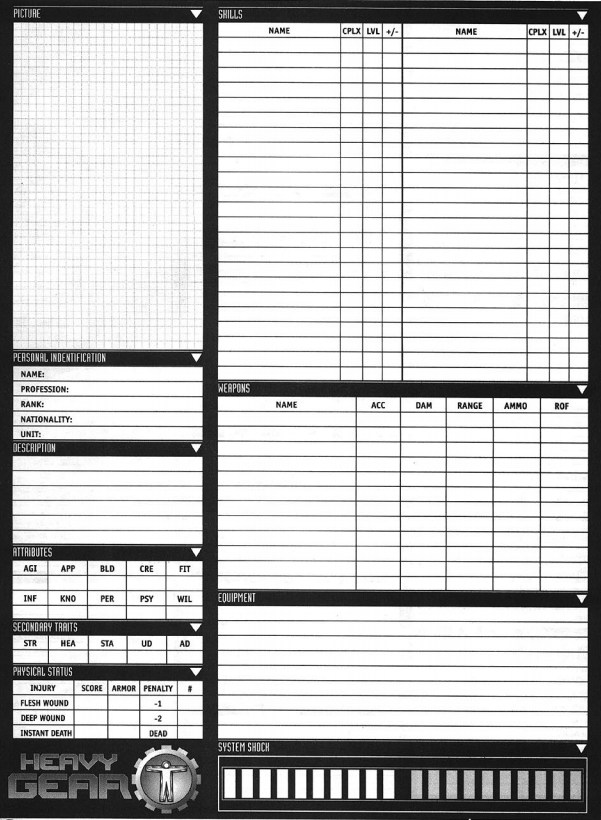
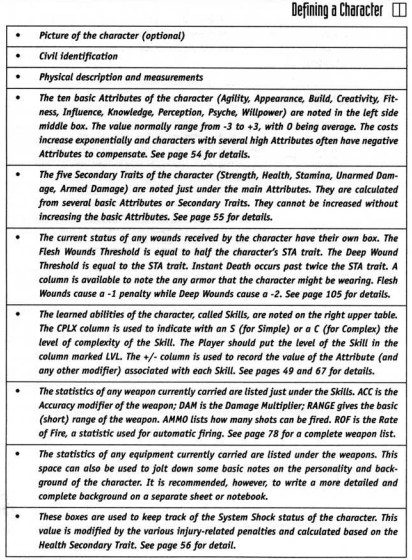
One thing I really dig about this system is how smooth and simple it is. Time and again, you'll see that Dream Pod-9 have done something with the rules that might twist the nipples of a simulationist, but that makes the game run smoother and cleaner, without sacrificing too much depth. I'll be covering a lot of them later, once we get to tactical rules, and such, but just look at how goddamn clean that character sheet is.
 I mean, I give this game a lot of crap for being BattleTech-lite, but that's not necessarily a bad thing.
I mean, I give this game a lot of crap for being BattleTech-lite, but that's not necessarily a bad thing.
Now that I'm done sucking DP9's cock, we can move on to actually making our characters. The first step is concept, but we already have those! We're given twenty questions to flesh our concept out. Nothing too deep, just basic stuff to help turn them into a person, rather than a pile of numbers. I'll just give them names for now. Our mecha pilot will be Shin , our thief will be Arsene , and our mechanic will be... Maria , because I can't think of the name of an anime character we're directly ripping off with her.
We move on to Step 2, buying attributes . Silhouette has 10 attributes, and 5 secondary traits, derived from them. The attributes are AGI lity, APP earance, B ui LD , CRE ativity, FIT ness, INF luence, KNO wledge, PER ception, PSY che, and WIL lpower. Most of them go without explanation, although it bears mentioning that Psyche covers mental health, empathy, and luck. The secondary traits are STR ength, HEA lth, STA mina, U narmed D amage, and A rmed D amage. Again, pretty simple.
When purchasing attributes, you're required to pick a campaign power level (Gritty, Adventurous, or Theatrical), and a character level (Average Joe, Player, and Major NPC). We'll be making three Adventurous PCs, which means they each get 30 points for Attributes. Attributes are a flat bonus to every skill you make associated with them, as well as the related traits, so raising them ends up pretty expensive.
Shin is a very talented Gear pilot, but he's a spineless jellyfish, and more than a bit unstable. Other than that, he's fairly average. He ends up with AGI and PER at +3, and WIL and PSY at -3, with everything else at 0. Right from the start, he's a min-maxer, and a completely fucked-up and incredibly unlucky human being who can't look past his own suffering to interact or empathize with others. Karma may or may not be involved. Finally, a protagonist goons can relate with!

Arsene resolves to not sink any of his stats to embarrassing levels, but still be able to do what he wants to do. Peeking forward a bit to see what attributes the skills he wants to use are based on, he ends up with an AGI and PER at +1, and APP and INF at +2. Arsene's also a bit of a jerk, though, so he's got a PSY of -1.
Maria's sharp, and she's not bad-looking, but she's lazy, and doesn't really put a lot of effort into socializing. Still, she cares about the people close to her, it's just getting to that point that's the problem. She also doesn't tend to go outside or work out much. AGI, APP, and PSY at +1, CRE and KNO at +2, everything else at -1.
So, we've got a headcase, a mild sociopath, and a talented slacker. Should be fun!
Next, skills . Skills are split into simple and complex. The latter cost twice as much to train up as the former, and get significantly more expensive for each skill point beyond the first. Again, we get a certain number of skill points, based on the character and campaign style. The skill list is suitably mind-boggling, with everything from Earth Science, to Heavy Gear Pilot, to Parachuting.
Adventurous PCs give us 40 Skill Points, enough for a moderate range of effective skills, or a couple very high ones. Also worth noting is that you must have at least a modifier of (Skill Rank -2) to pick up a skill. Shin won't be able to learn to tell what people think of him until he stops being quite such a dickball.
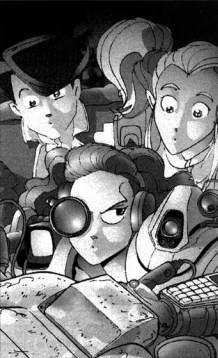
To break up all these words, have a picture of three people all making the exact same facial expression.

Shin is a dirty min-maxer, and so he ends up with Gunnery (Gear) and Heavy Gear Pilot, both complex skills, at 3. He has only a few points left, and he puts them into Dodge 2. It's almost like he knows there's going to be an inevitable fist coming his way.
Arsene goes for mostly social skills, but also picks up some thiefish skills as well, and proficiency with small arms. He's not much for combat, but in a focused campaign, he might be the guy that sneaks into bases and performs pre-mission sabotage on the enemy. He also grabs a bunch of other skills that might be relevant at 1, because he's had to learn a lot of things to avoid getting caught, and/or in prison in the past. (He's also hoping that, with a wide array of skills, he'll be able to convince the GM to let him use one in most situations.) Final list: Disguise 1, Dodge 2, Etiquette 2, Forgery 1, Gambling 1, Human Perception 1, Notice 1, Security 1, Seduction 2, Small Arms 2, Stealth 2, Streetwise 2, Theatrics 2
Maria has a much more specific set of skills in mind, and doesn't bother too much with those outside of them, although she doesn't minmax nearly as badly as Shin, and still has a few to let her function like a normal human being. Drive 2, Electronic Warfare 2, Electronics 2, Etiquette 1, Gunnery (Tank) 1, Mechanics 2, Streetwise 1, Tinker 2. She ends up being a competent mechanic, and Tank driver, but excels at neither, which suits her just fine.
Apparently, only now can we work out our secondary traits (UD and AD factor in Hand-to-Hand and Melee skill, respectively. None of our characters have any of those.) Still, the math is simple enough, and we quickly begin to see how boned these three are in the personal combat sector.
Shin has a perfectly average STR of 0, and UD and AD of 3, but because of his god-awful WIL and PSY, his HEA is -2, and so his STA is 15. Shin brusises like a banana, and getting stabbed once could easily be instant death. As in, "overkill damage threshold" instant death.
Arsene's a bit more lucky. He's also got a STR of 0, and UD and AD of 3, but despite his below-average PSY, it's not below-average enough to keep his HEA below 0, or his STA below 25. This is perfectly average, which makes him a good baseline.
Maria's... fucked. Her series of -1s all come back to bite her at once. She's got Shin's terrible HEA and STA, but she's also got a STR of -1, and UD and AD of 1. Girl's a reed.
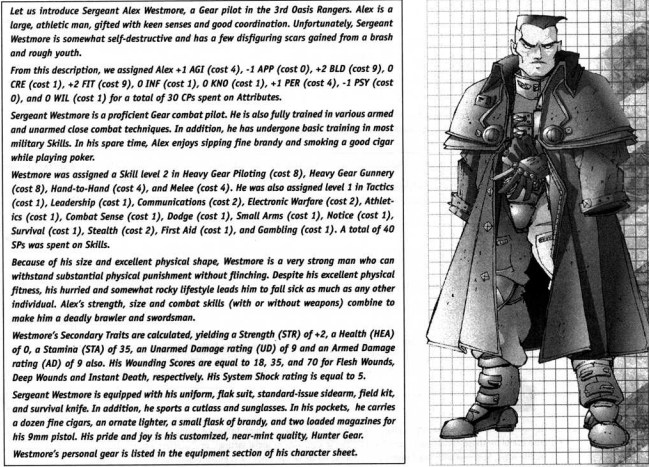
For comparison, here's the book's sample character.
The last step is gear . The list of gear is a reasonably-sized sub-chapter, though most of it is pretty generalized. The exception here is weapons, of which there is a giant list, and armor, which comes in light, heavy, and turtleshell. Suppose that's to be expected of a wargame, though. The game suggests either grabbing everything that one of the sample characters (apparently, there are sample characters at the end of the chapter!) has got, or asking your GM how much starting money everyone should have. There's no guideline for how much this should be in the core book.

Shin gets the Gear Pilot's set, which is just a flight suit, a helmet, and a knife and 9mm pistol he'll probably hurt himself if he tries to use.
Arsene gets the private investigator's equipment: Cell phone, data disks, night vision goggles, personal computer, and a trideo recorder. He also takes Shin's pistol, since he'll never use it anyways.
Maria zooms in on the field technician set, which is a 'dataglove', mechanical and electronic tools, a military-level comm set, and the wonderfully generic "tech gear".
So, after all that, we have exactly what we came for: A psychological timebomb completely useless outside of a Gear, a suave thief who really shouldn't get in a fight, and a tank driver/mechanic, who really, really shouldn't get in a fight.
Up Next They get in a fight!
Rest in Peace, Noble Weeaboo
Original SA post Heavy Gear Second Edition, Part 4: Rest in Peace, Noble Weaboo(For the length of this update, any time I use the word "combat", assume I mean only on-foot combat unless specified otherwise)
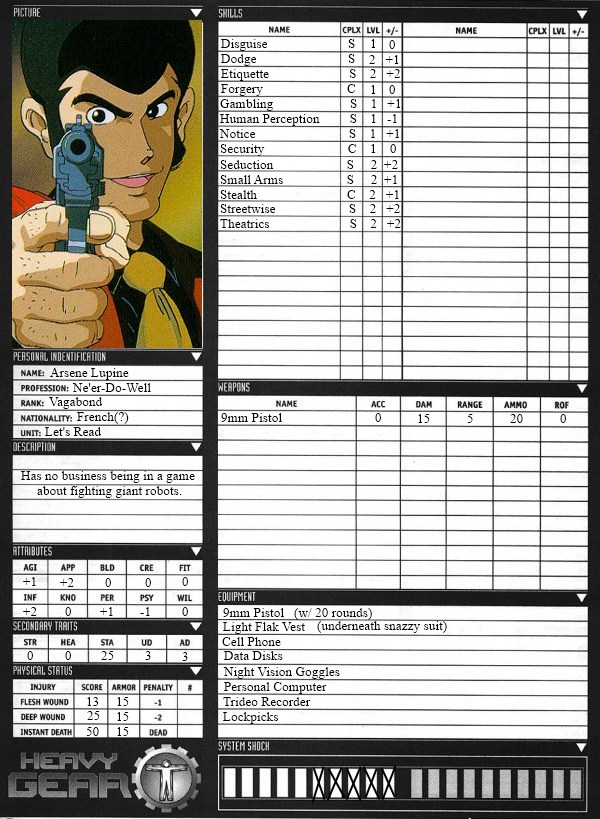
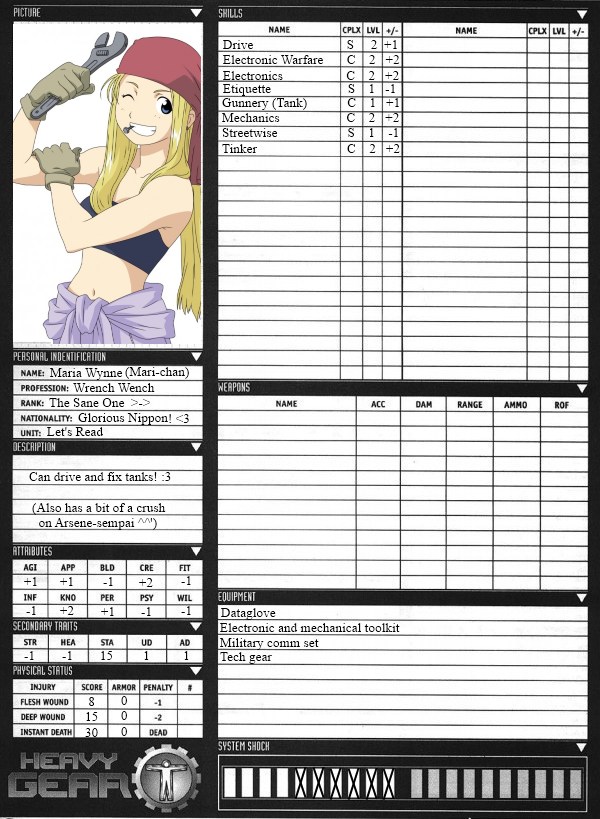
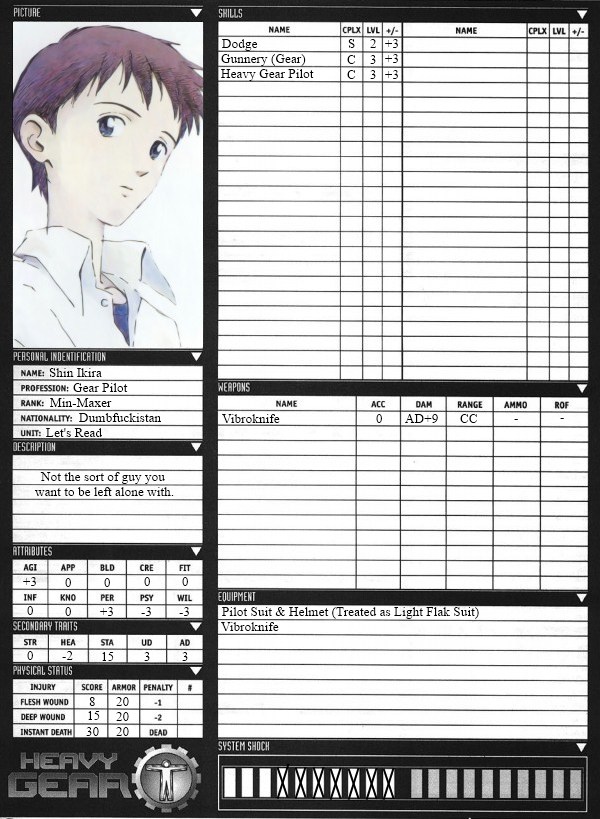
I made our dysfunctional trio proper character sheets, so now we can destroy them utterly. Oh, didn't I mention? Heavy Gear's on-foot combat rivals Dark Heresy and early D&D dungeons for flat out "kill you on an unlucky roll" lethality.
Chapter Six begins with a quick recap of how tests work, gives some possible suggestions about how to run them (whether or not to tell the player the Objective number, etc), and mentions that, if you're testing an attribute or trait directly (for example, a Health test to avoid getting sick, or a Psyche test, the system-standard "luck" check), then you always roll two dice, and pick the higher, as if the character had two skill ranks. It's simple enough, but mentions a few other things, such as Emergency Dice, which it doesn't explain for a while yet.

I could go ahead and just summarize the combat rules, but I'm not sure how I'd manage to keep it enjoyable and informative, without imparting more information than a Let's Read should really provide. Instead, I'll run a sample combat.
Our trio of intrepid weirdos has gone to a bar, for some wacky hijinks, and in hopes that getting some alcohol in Shin will make him stop whining for a few minutes. Instead, they've gotten in a bar fight, that's taken a turn for the deadly!
On-foot combat in Heavy Geat is a lot like Gear combat, so you can imply a lot of one from the other. The biggest differences are that on foot, movement is abstracted or ignored entirely, and being wounded uses a much more simple system. But we'll get to that is a second.
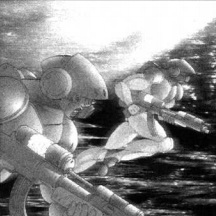
Here, have some art.
Our fight is the three morons, versus three "Average Joes", who are assumed to have all stats at 0, and two dice in a handful of related skills, or just "every roll", if you're lazy, which I am. Since equipment is fairly important, we'll say that they're all wearing thick leather jackets which count as light flak vests (15 Armor), one has a club (AD+5), one has a knife (AD+7), and one has his fists (UD). We'll call them Ozzy, Slash, and Flea, respectively.
Every combat, and every round of combat, begins with a roll of Combat Sense by everyone. Highest result goes first, and then down the list. Those who tie act simultaenously. If you don't have any points in Combat Sense, you're probably not going to do very well, because if you fumble a Combat Sense roll, you lose your turn completely, unless you're already in the middle of an extended action. You can see how this can quickly get out of hand. And guess which party has precisely no one who has Combat Sense?
Ozzy rolls a 4. (2, 4) Slash rolls a 6. (6, 3) Flea rolls a 2. (2, 2) Arsene gets a 2. (2, 6) Maria gets a 2 as well. (5, 2) Shin does reasonably well, surprisingly enough, and gets a 4. (4, 4) (So much rolling! This is one of the parts where it being a wargame first starts to show.)
Slash goes first. Everyone can move, and use one action during their turn. Each extra action imposes a cumulative -1 penalty to ALL actions during that turn. (2 actions at -1, 3 at -2, etc.) Boring, complex math is involved in figuring out exactly when's best to take how many actions, but since no one here is really good at anything, Slash will simply move up to Maria (who was dumb enough to not wear any armor), and stab at her with his knife.
Attacks are always opposed rolls, and there's a fairly long list of bonuses and penalties for attackers and defenders. What's important here is Margin of Success, because on a hit, your damage is equal to your weapon's damage multiplier, times your MoS. High damage weapons become very deadly, very quickly.
Slash was moving at walking speed (-1 attack), and we'll ignore most of the other modifiers because otherwise this will quickly devolve into "who can fail the least emberassingly". We'll assume everyone's equally intoxicated, and in the most well-lit alley that's ever existed. Maria, gets a (-1 defense) because she's standing still, but a +1 from her Agility. That means Slash is rolling 2d-1, while Maria's rolling a straight unskilled roll (which I'll be shortening from now on as Ud).
Slash gets a 5 (2, 6), while Maria gets our first fumble. (3, 1) A fumble on an attack or defend is treated as a 0, regardless of modifiers (you can't go below 0), and the opponent automatically hits (unless they also fumbled). This means that Slash has gotten 5 MoS on his first attack. With an AD of 5, that means he's doing ([5+7]*5) 60 damage. We then compare that to Maria's injury list. Since 60 is well above the threshhold of 30 needed for an instant kill on her, she dies instantly, with a knife wound to somewhere vital.

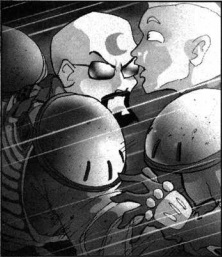
Sort of like that!
Ozzy and Shin go at the same time, and they both move to advance on each other, and attack with their respective weapons. It'd be dramatic if Shin wasn't about to get horribly murdered. We'll roll his attack first, because I want to watch him fail. An unskilled Melee roll, while walking, but with Shin's huge Agility bonus comes out to (Ud+2), versus a two-dice defensive roll, while walking (2d).
Shin gets a 4 (2, 3), and Ozzy gets a 5 (5, 4). Shin misses. 2d-1 vs 2d+3. ...and Ozzy fumbles (1, 1), while Shin somehow manages to roll an 8. (5, 5) What.

Flea and Arsene also go at the same time. But while Flea moves up to attack, Arsene backs up, and shoots his pistol at Flea. ...well, we can't say this fight didn't get very real very quickly. We'll roll Arsene first. He's walking, versus Flea, who has to now jog to close the distance (+1 defense). That's 2d even, versus 2d+1. Arsene rolls amazingly, and gets a 7. (6, 6). Flea gets a 5. (2, 4). That's 2*15 = 30 damage. With a natural Flesh Wound score of 13, plus the 15 from armor, this puts Flea's final Flesh Wound threshold at 28. The damage is above the Flesh Wound threshold, so the bullet hits him somewhere non-vital, and Flea'll take a -1 to all future actions until it heals. Four more wounds of any type, and he'll go into shock.
But, since it's simultaneous, his current action is unaffected. He's running (-2 attack), versus Arsene who is walking, so the total comes out to 2d-2 versus 2d+1. Result: 4 (6, 2) vs 3 (2, 1). Arsene takes 10 damage, which would be below his flesh wound score even if he wasn't wearing armor. Flea lands his punch, but doesn't manage to do any real, lasting damage.
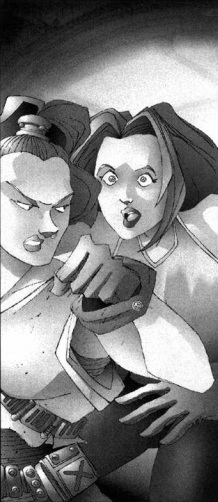
Goddammit, Heavy Gear, you were doing so well!
So, at the end of the first round, one PC has been killed out-right, one's not going to hit the broad side of a barn, and the third had to bring a gun to a knife fight to even stand a chance. This is what happens if you don't put at least some points into basic combat skills in a game where a single lucky hit can kill you outright.
...I think I'll move on now.
Next Time: Special combat rules, and recovering from the beating you just took!